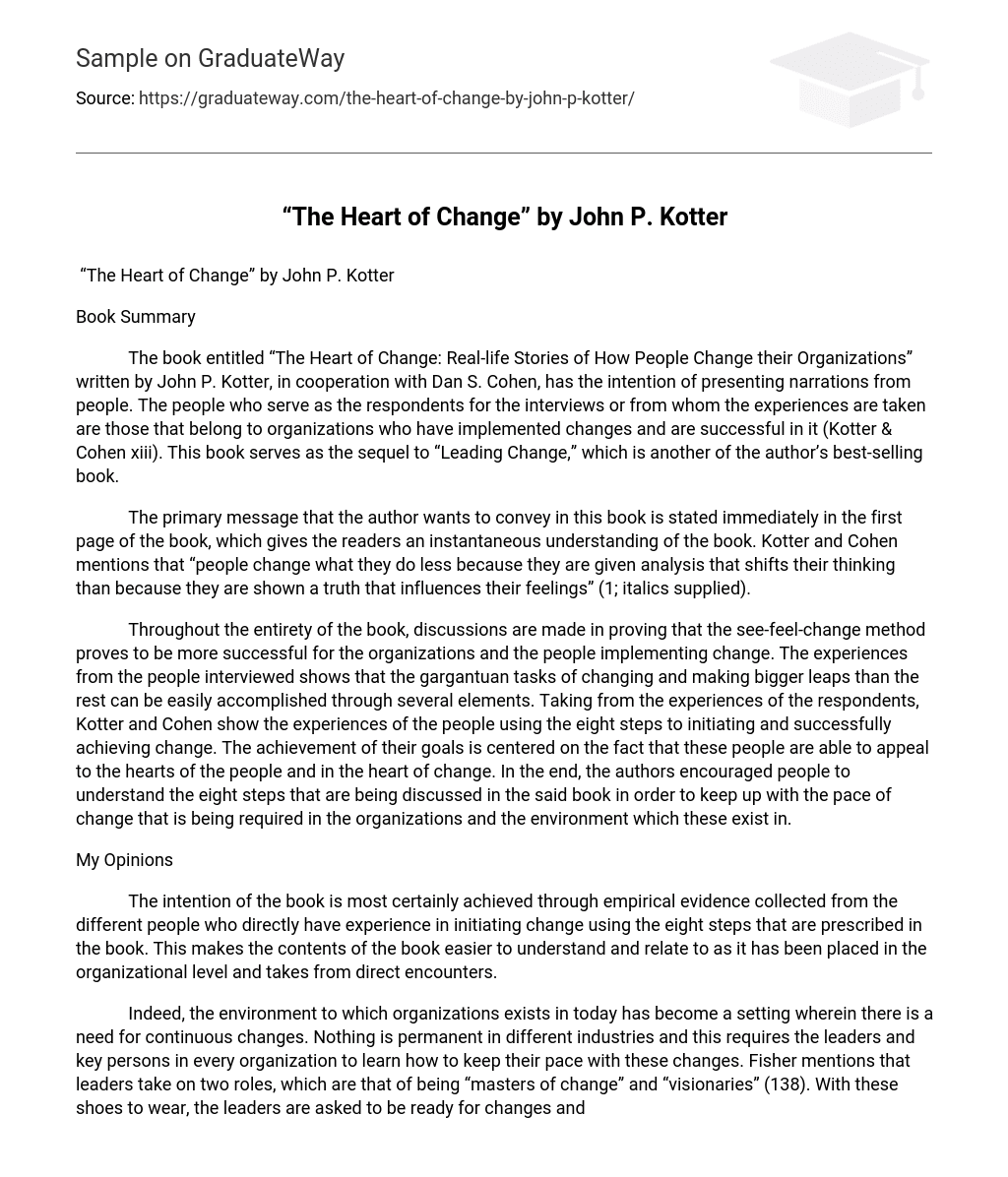Book Summary
The book entitled “The Heart of Change: Real-life Stories of How People Change their Organizations” written by John P. Kotter, in cooperation with Dan S. Cohen, has the intention of presenting narrations from people. The people who serve as the respondents for the interviews or from whom the experiences are taken are those that belong to organizations who have implemented changes and are successful in it (Kotter & Cohen xiii). This book serves as the sequel to “Leading Change,” which is another of the author’s best-selling book.
The primary message that the author wants to convey in this book is stated immediately in the first page of the book, which gives the readers an instantaneous understanding of the book. Kotter and Cohen mentions that “people change what they do less because they are given analysis that shifts their thinking than because they are shown a truth that influences their feelings” (1; italics supplied).
Throughout the entirety of the book, discussions are made in proving that the see-feel-change method proves to be more successful for the organizations and the people implementing change. The experiences from the people interviewed shows that the gargantuan tasks of changing and making bigger leaps than the rest can be easily accomplished through several elements. Taking from the experiences of the respondents, Kotter and Cohen show the experiences of the people using the eight steps to initiating and successfully achieving change. The achievement of their goals is centered on the fact that these people are able to appeal to the hearts of the people and in the heart of change. In the end, the authors encouraged people to understand the eight steps that are being discussed in the said book in order to keep up with the pace of change that is being required in the organizations and the environment which these exist in.
My Opinions
The intention of the book is most certainly achieved through empirical evidence collected from the different people who directly have experience in initiating change using the eight steps that are prescribed in the book. This makes the contents of the book easier to understand and relate to as it has been placed in the organizational level and takes from direct encounters.
Indeed, the environment to which organizations exists in today has become a setting wherein there is a need for continuous changes. Nothing is permanent in different industries and this requires the leaders and key persons in every organization to learn how to keep their pace with these changes. Fisher mentions that leaders take on two roles, which are that of being “masters of change” and “visionaries” (138). With these shoes to wear, the leaders are asked to be ready for changes and even to be the initiators of change in the environment and industries they belong to. However, change does not stand in the planning or initiation stage alone and the success of it can not be determined without implementation. In achieving change set forth by leaders in the organization, there should be a careful understanding of what can be seen and what can be subsequently felt for changing.
As the human components of the organizations prove to be an important aspect nowadays, it has also become necessary for change to be given a heart and consider the emotional aspects of it.
Success of change can not be bound on the rational aspects alone because of the inability of these methods to embrace the positive aspects associated with seeing and feeling. There are more elements that are missed by looking on the rationality of a decision alone. There are real experiences and logic that can be found to support the viability of the see-feel-change method today.
On the other hand, there are more changes that are expected to come in the next decades in the way organizations handle change. People, most especially the leaders, should not limit their perspectives when it comes to change simply because a method is proven to be effective today. It is expected that in the coming days, the context upon which these organizations operate change and this requires a new way of seeing change.
Issue for Thought
With the discussions made in the book “The Heart of Change: Real-life Stories of How People Change their Organizations,” is it then possible to say that there should be more attention given to see-feel-change than in analysis-think-change? Should the latter be considered as a thing of the past?
In thoughts, there should be a balance between the two approaches such that the appropriate one is used as needed. There are certain types of changes that require people to place in analysis along with seeing and put together thinking and feeling. The analysis-think-change approach should still be used as previously mentioned because of the advantages that are attached to it.
Works Cited
Fisher, Kimball. Leading Self-Directed Work Teams: A Guide to Developing New Team Leadership Skills. NY: McGraw-Hill, 1999.
Kotter, John & Cohen, Dan. The Heart of Change: Real-life Stories of How People Change their Organizations. Boston, Massachusetts: Harvard Business School Publishing, 2002.





